The basics
Early this morning, Israel launched Operation Rising Lion,1 a massive air campaign aimed at Iran’s nuclear program. The first wave, which began at about 3:30 am in Iran, took out command-and-control centers, ballistic missile bases, and air defense batteries. Meanwhile, covert Mossad agents sabotaged Iran’s radar, missile silos, and drone bases, using precision munitions they’d somehow smuggled into Iran. At least four more waves of aircraft followed, involving at least 200 aircraft.
It looks as if the Iranian military disintegrated on contact. (It also looks as if Israel’s intelligence in Iran is so good that they chose their targets by picking the 30-odd Iranians who weren’t working for them.)
The strikes are ongoing. As I type this, Israel is attacking Fordow, which they didn’t last night. (I thought this was because Fordow’s buried under a mountain and Israel wasn’t capable of reaching it, but I seem to have been wrong.)

The IDF says they’ve done “significant” damage to Natanz, the largest uranium enrichment site. They say the underground section of the site, which housed “a multi-level enrichment hall housing centrifuges, electrical rooms, and other supporting infrastructure,” as well as “critical infrastructure enabling the site’s continued operation and advancement of the Iranian regime’s nuclear weapons project” has been destroyed.
This is said to be footage of the strike:
It’s hard for me to assess how much damage has been done: I’m not there, after all. But I suspect the underground enrichment facilities at Natanz won’t be operational again for a good long time.
Other nuclear sites were hit in Isfahan, Khondab, Khorramabad, and Tabriz. The Arak heavy-water reactor was targeted. Key radar and missile-production installations were razed in Hamadan and Kermanshah.
They decapitated the Iranian military. They turned the head of the IRGC, General Hossein Salami—the chief strategist of Iran’s proxy warfare policy—into General Chopped Liver. They whacked Armed Forces Chief Mohammad Bagheri, General Amir‑Ali Hajizadeh, General Gholamali Rashid, and (at least) two prominent nuclear scientists.
They hit a few residential areas that house officials, too. Dozens have reportedly been injured in Tehran, but the casualty figures thus far seem surprisingly low to me given the scale of the operation. Perhaps the numbers will change.
Iran announced this was a “declaration of war” (you think?) and vowed retaliation. This morning, they lobbed a hundred drones at Israel, which were promptly intercepted.
Israeli security officials say the strikes will continue for “days or weeks.” As I write this, Israel is conducting a new round of strikes—at least, to judge from Iranian state TV, which is reporting explosions in East Azerbaijan. Israel may have struck Tabriz early this afternoon, near the airport, too. More explosions were heard at Shiraz and Natanz. A “loud and terrifying” sound was reported near Nojeh Air Base in Kabudar, in Western Iran.
Just now, the IDF said it continued to strike Iran “with full force.”
The UK, the EU, Saudi Arabia, and Turkey have issued shrieks of alarm, as have the usual suspects:
The UN has called for calm, which I suspect will not achieve much.
Brent crude surged ~8 percent to US$78–79. US equity futures sank. Gold and bonds rallied.
The US claims it has no operational involvement, but multiple reports say we’ve been sharing intelligence and offering logistical support. Reportedly, Israel is now attempting to persuade the US to join the operation. (I’m guessing they want our help, in particular, with Fardow—but I’m not sure.)
Iranian authorities seem to have restricted or cut off access to the Internet.
Update: Seems Iran has some missiles left:
Mossad set up a drone base in Iran, UAVs took out missile launchers overnight. Assault was product of years-long collaboration between IDF and intelligence agency, involved smuggling weapons systems into Iran on vehicles:
… Mossad agents set up a drone base on Iranian soil near Tehran. The drones were activated overnight, striking surface-to-surface missile launchers aimed at Israel. In addition, vehicles carrying weapons systems were smuggled into Iran. The third covert effort was Mossad commandos deploying precision missiles near anti-aircraft sites in central Iran. The operations relied on “groundbreaking thinking, bold planning and surgical operation of advanced technologies, special forces and agents operating in the heart of Iran while evading the eyes of local intelligence,” the official said.
Israel’s strike on Iran was eight months in the making:
Israel’s stunning and sprawling operation overnight targeting Iran’s nuclear facilities, missile sites, scientists and generals followed eight months of intensive clandestine preparations. … The operation launched a new war in the Middle East that could draw in the US, demolished any hopes of a nuclear deal, and dealt arguably the biggest single blow to the Iranian regime since the 1979 revolution. And it is only just beginning.
Israel is attempting to “eliminate” Iran’s nuclear and ballistic missile capabilities in an operation expected to last at least several days, Prime Minister Benjamin Netanyahu announced. Other Israeli officials said it could take weeks. Israel attempted—just in the opening hours—to assassinate nuclear scientists it claims had the know-how to make a nuclear bomb. Around 25 scientists were targeted and at least two are confirmed dead so far. Israel also targeted the entire top brass of Iran’s military. The commander of the Revolutionary Guard and military chief of staff were both confirmed dead, along with another senior general.
The idea for an operation simultaneously targeting Iran's missile and nuclear programs … took hold after Iran struck Israel in October, during a cycle of tit-for-tat escalation between the countries. Motivated both by Iran’s fast-growing missile arsenal and its weakened air defenses following Israel’s retaliation, Netanyahu ordered the military and intelligence services to begin planning. The Israeli military said another factor was intelligence about nuclear weaponization research and development that indicated Iran could build a bomb more quickly if it elected to do so. The planned opening in the coming weeks of a new underground enrichment facility that would be immune to even massive US bunker busters added to the urgency.
Even as President Trump pursued a nuclear deal, Israel was preparing for this strike—gathering intelligence, positioning assets and eventually conducting drills. Those preparations alarmed some in the White House, who worried Netanyahu might move even without a green light from Trump. Netanyahu assured Trump he wouldn’t. The White House, for its part, told Netanyahu that if Israel attacked Iran, it would do so alone. Trump himself said several times in recent days, including several hours before the strikes, that he opposed an Israeli strike that could “blow up” the negotiations. But in the hours after the attack began, Israeli officials briefed reporters that this was all coordinated with Washington.
Macron says Iran responsible for destabilizing region:
After a day of talks with regional and international leaders following Israeli strikes on Iranian military targets, notably its nuclear sites, Macron says Tehran was close to a “critical point” in acquiring a nuclear weapon.
“Iran bears a very heavy responsibility for the destabilization of the region,” Macron said. “Iran is continuing to enrich uranium without any civilian justification and to levels that are very close to what is needed for a nuclear device.” While he urged restraint, Macron acknowledged that resuming diplomatic efforts, specifically US negotiations on a nuclear deal with Iran that started two months ago, would be difficult. “The current situation has a risk of uncontrolled escalation,” he said, adding that Iran’s activities threatened Europe. Warning of a possible impact on the global economy, Macron said France would defend Israel if it was attacked by Iran as it had done in the past, but he ruled out taking part in any operation against Tehran.
Why did Israel strike now? The context.
On May 31, the International Atomic Energy Agency published its quarterly report on the status of Iran’s compliance with the 2015 UN Security Council resolution 2231, which includes the provisions of the JCPOA. Among other things, the IAEA reported a consistent pattern of Iranian obfuscation: site sanitization, stymying inspectors, uranium traces at undeclared locations.
The Institute for Science and International Security (the “good ISIS,” as they call themselves) published an analysis of the report, as they typically do:
Iran’s nuclear weaponization program is steadily making progress, out of sight of the inspectors and the world. The urgent need is to place IAEA inspections at heart of relations with Iran and reaffirm that Iran will never be allowed to get a nuclear weapon.
The IAEA’s key findings, ISIS said, included the following. (You can skim this, but you shouldn’t. You’ll be hearing from everyone and his mother that Iran wasn’t really close to building a bomb. It’s nonsense. Netanyahu was not wrong to think it was now or never.)
Iran can convert its current stock of 60 percent enriched uranium into 233 kg of WGU (weapons grade uranium) in three weeks at the Fordow Fuel Enrichment Plant (FFEP), enough for 9 nuclear weapons, taken as 25 kg of weapon-grade uranium (WGU) per weapon.
Iran could produce its first quantity of 25 kg of WGU in Fordow in as little as two to three days.
Breaking out in both Fordow and the Natanz Fuel Enrichment Plant (FEP), the two facilities together could produce enough WGU for 11 nuclear weapons in the first month, enough for 15 nuclear weapons by the end of the second month, 19 by the end of the third month, 21 by the end of the fourth month, and 22 by the end of the fifth month.
In front of the inspectors’ eyes, Iran is undertaking the near-final step of breaking out, now converting its 20 percent stock of enriched uranium into 60 percent enriched uranium at a greatly expanded rate, although this rate cannot be sustained much longer (see below). (My emphasis, as is everything in bold, below.)
Iran has no civilian use or justification for its production of 60 percent enriched uranium, particularly at the level of hundreds of kilograms. Its rush to make much more, quickly depleting its stock of near 20 percent enriched uranium, which has a civilian use in research reactors, raises more questions. Even if one believed the production of 60 percent is to create bargaining leverage in a nuclear negotiation, Iran has gone way beyond what would be needed. One has to conclude that Iran’s real intent is to be prepared to produce large quantities of WGU as quickly as possible, in as few centrifuges as possible.
Not surprisingly, and in its understated style, the IAEA reiterated in this most recent report: “The significantly increased production and accumulation of highly enriched uranium by Iran, the only non-nuclear-weapon State to produce such nuclear material, is of serious concern.”
Because of the greatly expanded production of 60 percent enriched uranium, the IAEA previously requested and received permission for strengthened safeguards at Fordow.
The IAEA also previously reported the implementation of a “strengthened safeguards approach […] at a nuclear material storage at Esfahan,” an important development given that a large amount of Iran’s 60 percent HEU and 20 percent enriched uranium stock have previously been reported to be stored at Esfahan. Exactly how much of Iran’s enriched uranium stocks are held at Esfahan, however, compared to other locations, is no longer reported.
The IAEA’s efforts to verify Iran’s nuclear activities, particularly its uranium enrichment activities, continue to be seriously affected by Iran’s decision last fall to withdraw the designation of several experienced inspectors. The IAEA repeatedly requested that Iran reconsider this inappropriate, political act, including in a June 2024 Board of Governors censure resolution, but Iran has not done so. The IAEA stated in its accompanying report, NPT Safeguards Agreement with the Islamic Republic of Iran: “The withdrawal of the designation of several experienced inspectors was also not in line with the required spirit of cooperation.”
As of May 17, 2025, the net overall enriched uranium stock, including all levels of enrichment and all chemical forms, had increased by 953.2 kg, from 8294.4 kg to 9247.6 kg (Uranium mass or U mass).
As of May 17, Iran’s stockpile of 60 percent HEU in the form of uranium hexafluoride was 408.6 kg (as measured in U mass) or 604.4 kg (hex mass). This represents a net increase in the stock in the form of uranium hexafluoride of 133.8 kg (U mass) since the previous reporting period. It does include 6.5 kg of enriched uranium (U mass) that is assessed to be enriched above 20 percent but far below 60 percent, as it was discharged from the cascade into a dump tank rather than collected as product.
Since December 5, Iran has been using 20 percent feedstock rather than 5 percent feedstock to produce 60 percent HEU in the two interconnected IR-6 cascades used for 60 percent HEU production since November 2022. This change led to an average monthly production of 33.5kg 60 percent HEU at Fordow during this most recent reporting period. The two IR-6 cascades used include one of which is easily modifiable to change operations and enrich uranium to higher levels.
Iran continued to produce 60 percent HEU from 5 percent low enriched uranium (LEU) feed in two pairs of interconnected advanced centrifuge cascades at the above-ground Pilot Fuel Enrichment Plant (PFEP).
Adding the average monthly production of 60 percent HEU at the PFEP, which slightly increased to 4kg per month, Iran is producing 37.5 kg (U mass) or 55.5 kg (hex mass) of 60 percent enriched uranium per month on average. It could produce about 675 kg (hex mass) or 456 kg (U mass) of near 60 percent enriched uranium per year.
However, in multiplying its 60 percent HEU production, Iran is using significant amounts of 20 percent enriched uranium as feedstock, a rate which is not sustainable unless Iran significantly increases 20 percent enriched uranium production. It used an average of 117 kg (U mass) of 20 percent enriched uranium as feed per month, compared to an average monthly production of 14 kg.
This led to a reduction in Iran’s near 20 percent enriched uranium stock in the form of uranium hexafluoride of 332.3 kg (U mass), for a total stock of 274.5 kg (U mass) as of May 17, 2025.
At this feed and production rate, Iran could sustain the high 60 percent HEU production for approximately three months after May 17.
Iran now has nearly 14,689 advanced centrifuges installed at Natanz and Fordow, where most are deployed at the Natanz Fuel Enrichment Plant (FEP).
Including the installed IR-1 centrifuges at the FEP, PFEP, and FFEP brings the total number of installed centrifuges to roughly 21,900. It should be noted that many advanced centrifuges are deployed but not enriching uranium, and the IR-1 centrifuges have a reduced ability to enrich uranium.
During the reporting period, Iran installed five new IR-4 cascades at Natanz, for a total of 23 total IR-4 cascades, 12 of which are operating.
Iran made no progress in this reporting period on installing the massive cascade consisting of 1152 IR-6 centrifuges.
The quantity of Iran’s enriching centrifuges increased during this reporting period, to approximately 18,000 centrifuges.
Iran has a total installed enrichment capacity of roughly 64,000 swu/year. Its enriching centrifuge capacity is less, approximately 50,000 swu/year.
Iran’s stockpile of near 5 percent LEU in the form of UF6 increased by 1853.4 kg (U mass) from 3655.4 kg to 5508.8 kg (U mass), or 8149.1 kg (hex mass).
In general, Iran has not prioritized stockpiling uranium enriched between 2 to 5 percent. This choice is at odds with Iran’s contention that its primary goal is to accumulate 4 to 5 percent enriched uranium for use in nuclear power reactor fuel. Instead, Iran has focused on producing 60 percent enriched uranium, far beyond Iran’s civilian needs.
The IAEA again reports that Iran will not start commissioning of the Arak reactor, now called the Khondab Heavy Water Research Reactor (KHRR), or IR-20, until at least 2025, with operation expected to start in 2026. Inspectors again did not observe any significant changes at the reactor, noting this time only minor civil construction.
Iran stopped implementing the Additional Protocol (AP) to its comprehensive safeguards agreement (CSA) and the JCPOA’s additional monitoring arrangements on February 23, 2021. Iran’s actions and its refusal to cooperate with the IAEA across a wide range of monitoring issues causes the IAEA to consistently express doubt about understanding key aspects of Iran’s nuclear activities. Without the AP in place, the IAEA has neither been able to conduct complementary access to any sites and other locations in Iran nor received updated declarations from Iran.
The IAEA reports that it has “lost continuity of knowledge in relation to the production and current inventory of centrifuges, rotors and bellows, heavy water and UOC [uranium ore concentrate], which it will not be possible to restore.”
The IAEA concludes that “Iran’s decision to remove all of the Agency’s equipment previously installed in Iran for JCPOA-related surveillance and monitoring activities has also had detrimental implications for the Agency’s ability to provide assurance of the peaceful nature of Iran’s nuclear program.”
Although the IAEA can ascertain the number of centrifuges deployed at Fordow and Natanz, it cannot know how many more Iran has made and stored or deployed at an undeclared site. A risk is that Iran will accumulate a secret stock of advanced centrifuges, deployable in the future at a clandestine enrichment plant, which would only need to house a relatively few advanced centrifuge cascades to enrich Iran’s current stock of 60 percent HEU to WGU. At the least, this situation complicates any future verification effort and contributes to uncertainty about the status of Iran’s nuclear activities and facilities.
Combined with Iran’s refusal to resolve outstanding safeguards violations and the program’s unresolved nuclear weapons dimensions, the IAEA has a significantly reduced ability to monitor Iran’s complex and growing nuclear program. The IAEA’s ability to detect diversion of nuclear materials, equipment, and other capabilities to undeclared facilities remains greatly diminished.
(By the way, in March, Tulsi Gabbard said that the intel community had concluded that “Iran is not building a nuclear weapon and Supreme leader Ayatollah Ali Khamenei has not authorized the nuclear-weapons program that he suspended in 2003.” Good old Tulsi—I sleep so much better at night knowing the Crown Jewels of American intelligence are in her hands.)
The IAEA’s board of governors has been meeting this week in Vienna. Yesterday, the US, Britain, France, and Germany submitted a resolution to censure Iran for advancing its nuclear program and violating its non-proliferation commitments. They noted, among other issues, that Iran hadfailed credibly to explain to the IAEA why uranium had been detected at undeclared sites. According to the BBC, the resolution said:
Iran’s many failures to uphold its obligations since 2019 to provide the agency with full and timely co-operation regarding undeclared nuclear material and activities at multiple undeclared locations in Iran ... constitutes non-compliance with its obligations … [The IAEA is] not able to verify that there has been no diversion of nuclear material required to be safeguarded … The inability ... to provide assurance that Iran’s nuclear program is exclusively peaceful gives rise to questions that are within the competence of the United Nations Security Council.
Yesterday morning, the IAEA formally found—for the first time in 20 years—that indeed, Iran was not in compliance with its obligations. This was historic. I’d bet quite a bit that it’s why Israel decided to strike immediately. Nineteen countries on the agency’s board voted for the resolution. Russia, China, and Burkina Faso opposed it; 11 abstained; two did not vote.
The passage of the resolution meant, in principle, that the UN Security Council could restore the massive economic sanctions on Iran that were lifted as part of the JCPOA. But in reality, no one believes the snapback sanctions would be effective. It’s not 2015 anymore. Russia and China would immediately bust them.
Iran was infuriated by the prospect of the passage of the resolution. It said unwise things. It threatened to leave the NPT. Iran’s foreign minister was extremely snippy:
(By “another strategic mistake,” he means, “passing the censure motion.”)
Iran also said it had built and would activate a third nuclear enrichment facility, “in a secure location”—which is exactly what the IAEA was worried about. In short: Iran was all but begging for it.
“An immediate operational necessity.” Why Israel finally attacked Iran’s nuclear facilities:
… In the assessment of Israel’s security establishment, the “nine bombs” figure may be an underestimation, the enrichment process may be even more advanced than the International Atomic Energy Agency has reported, and the weaponization process has featured advanced testing in recent days.
The aim of the Israeli strikes is to deeply damage Iran’s nuclear weapons capabilities—including key facilities and key commanders—and thus avert that perceived existential threat. The assessment in the security establishment is that this was the right and necessary moment to strike—before Iran has rebuilt defenses destroyed in Israel’s far less dramatic attack last October, and at a time when intel on the Iranian program is regarded as particularly strong.
While Netanyahu spoke of the imminent liberation of the Iranian people from tyranny, the goal is not to directly precipitate regime change. Indeed, the security establishment is talking only about thwarting the danger posed by Iran’s nuclear program, without bragging about completely destroying every aspect of the program.
The Bibi-cynics will note that Aryeh Deri, leader of the ultra-Orthodox Shas party, was threatening to dissolve the government over a dispute about drafting ultra-Orthodox men to the military, but word of the impending attack apparently persuaded him that now was not the time. I’m no great fan of Bibi, but unlike a growing number of Israelis—maybe a majority, even—I just don’t believe that his desire to stay out of jail is so great that he’d go to war with Iran to keep his coalition together. (I don’t even believe he’s prolonging the war in Gaza to stay in power.)
How did I get it wrong?
Yesterday, it was widely reported that European and US officials believed Israel was poised to attack Iran. The US withdrew its diplomats from Iraq, authorized the departure of military family members from the Middle East, and told US personnel in Israel not to travel beyond Tel Aviv, Jerusalem, and Be’er Sheva. The UK Maritime Trade Operations agency warned of a threat to commercial shipping in the region:
So why did I conclude all of this was probably a bluff?
My reasoning went like this. Trump was still saying he was opposed to an Israeli strike. “As long as I think there is a (chance for an) agreement, I don’t want them going in because I think it would blow it,” he said. He also posted this, presumably mere hours before Israeli planes began taking off:
In our Middle East 201 discussions, we’ve repeatedly asked whether Israel would be able, on its own, significantly to set back the Iranian nuclear program or even eliminate it. Our tentative conclusion—or mine, anyway—was “probably not.”
In August of 2024, with Biden still in power, Israel’s former ambassador to the United States, Michael Oren, wrote an article in the Israeli press calling for the US to lead a strike on Iran. It stuck in my mind, because he seemed to be saying that Israel couldn’t do it—the job required American long-range bombers and mega-bombs:
… an American attack would not last days, but only a few hours, thanks to the enormous offensive capabilities of the US military. America’s long-range strategic bombers, carrying bombs too large for the Israeli F-15 and F-35, are capable of flying at altitudes that cannot be reached by Iranian anti-aircraft missiles, and are not detectable by radar. The US would be able to eliminate Iranian nuclear facilities and vital utilities in just one night. The US warships of the Fifth and Sixth Fleets, inspired by President Reagan’s bombing of Iran’s oil facilities in 1988, would be capable of setting fire to all of Iran’s oil rigs in the Persian Gulf. In one fell swoop, the US would behead the snake and save the Middle East and the entire world from the Iranian nuclear threat.
(I just went back and read that column again. I see now that he did not, in fact, say Israel couldn’t do it with F-15s and F-35s. He simply said it would be faster if the US did it.)
I’ve spoken to many people, since then, about what would be required to take out Iran’s nuclear installations. The key sites are dispersed, hardened, and buried below mountains. Was there any way for Israel to destroy them, I wondered, without strategic bombers? For that matter, was there any way to destroy them with strategic bombers? Might eradicating them even be beyond the ability of the United States?
It seemed to me that I should know the answer to that question. But no firm answer was forthcoming. I received answers ranging from, “It would be impossible to destroy them—not unless you use nukes,” to, “Of course Israel could do it. That’s what they’ve been preparing to do for years.”
The consensus, to the extent there was one, was that to be sure of destroying those sites, you’d have to repeatedly drop our heaviest bunker-busters on them—over and over. But then again, maybe Israel could just hit the entrances, tunnels, and ventilation shafts—that was a possibility. So I concluded—tentatively—that Israel probably couldn’t do it without our help. A mountain is, after all, a hard thing to move.
Last April, The New York Times broke the story that Israel had developed plans to attack Iranian nuclear facilities in May. These plans required US assistance. They involved a combination of commando rids on underground nuclear sites and a bombing campaign.
Trump was initially open to the idea, the Times reported. General Kurilla was particularly keen, and with Trump’s blessing began moving B-2 bombers to Diego Garcia. (These are the kinds of bombers Michael Oren had in mind.) But according to the Times, a faction of the cabinet—led by Tulsi Gabbard, and supported by JD Vance and Pete Hegseth—talked Trump out of it. Trump told Netanyahu, who had flown to Washington to discuss the matter, that the US wouldn’t support the attack. He wanted to negotiate with Tehran, instead.
The story seems to have been accurate. Israelis were appalled, both that the details of their plans had been leaked and by Trump’s decision. They feared Trump would be snookered into signing, as Oren put it, “a deal that once again enriches Iran and enables it to rebuild Hamas and Hezbollah and restore a pro-Iranian regime in Damascus—all without dismantling a single centrifuge.”
Then Trump further horrified them by announcing, a visibly pained Netanyahu by his side, that he was holding direct talks with Iran. As Oren wrote:
At their joint Oval Office press conference Monday, President Trump made the brief but astonishing announcement that, “We’re having direct talks with Iran.” Previously, the president made no attempt to hide his desire to negotiate with Iran. Indeed, no sooner had he returned to the White House in January than he wrote to Iran’s Supreme Leader Khamenei and invited him to renewed talks. But now, suddenly, Trump has revealed that the talks are underway and will include, this Saturday, what he termed “a very big meeting.” More earthshaking still, though, was the revelation that the US and Iran are conducting these negotiations directly. That is something that not even President Biden, while committed to reviving the 2015 nuclear agreement, dared to do. Biden’s negotiators did not sit in the same room with the Iranians and passed messages back and forth to them through intermediaries.
Subsequently, the Trump Administration offered Iran a deal, according to some reports, that would have been more advantageous to Iran than the JCPOA. But the Ayatollah Khamenei, who had watched Trump negotiate with China and Russia and concluded that he was a patsy, a fool, and perhaps rather like some distasteful American dish called a “taco,” told him to piss right off.2
American and Iranian negotiators were scheduled to meet again on Sunday. (They still are, as far as I know. Bet that will be frosty.) But Trump seemed discouraged about the prospects for diplomacy: Last Monday, he said, “They’re not there. I hate to say that, because the alternative is a very, very dire one.”
He also said, clearly, that he didn’t want Israel to strike. Just yesterday, he said, “I don’t want them going in, because I think that would blow it.” (By “it,” he means a deal.)
It wasn’t just him. Also yesterday, the Israeli journalist Itamar Eichner published an interview with US Ambassador to Israel, Mike Huckabee, in Hebrew. It seemed extremely clear:
Amid high tensions in the Middle East and extraordinary instructions from the United States to its embassies “within Iran’s strike range,” US Ambassador to Israel Mike Huckabee sat down for an interview, conducted Wednesday afternoon. Huckabee estimates that Israel will not attack Iran without a “green light” from Washington—but clarifies that it will ultimately have to make its own decision. …
If negotiations collapse and the US turns to the military option, do you think it would act alone or with Israel?
“I don’t think I can give a definitive answer. It depends—both countries must make their own decisions about how they want to participate and what they want to do. I’m not in a position to say how this would unfold militarily.”
Can you confirm that the President asked Prime Minister Netanyahu to take the military option off the table—or at least to stop talking about it for now?
“I can’t say the President gave specific instructions. I know they’ve had many conversations and have discussed every aspect, but it’s not in the President’s style to give orders to a Prime Minister—just as it wouldn’t be typical for a Prime Minister to give orders to a President. …
Do you see a scenario where Israel launches a military strike without a “green light” or at least coordination with the US?
“I won’t be the one making that decision, but I don’t envision such a scenario as likely—because of the closeness of the relationship and the trust. And that’s the word I would emphasize: trust. There is trust between the US and Israel. I say this often: we have friends, we have allies, but we have only one partner—Israel. When I say that, I don’t mean we lack deep relations with other countries, but no other country has this level of cooperation with us—in intelligence, in military equipment, in strategy, in shared goals. Much of that stems from our common foundation: a civilization based on a Judeo-Christian worldview.”
There’s no way other way to interpret this: Trump, clearly, told Israel, “Don’t do it.” This was a message of deterrence. It was definitely not a green-light. It would be, I thought, highly unwise for Israel openly to defy Trump, if only because they need our help to intercept the drones and missiles Iran would launch in retaliation. Trump would be all too capable of refusing that assistance out of pique that Netanyahu had defied him.
So no, they wouldn’t do it, I figured. Probably, they couldn’t. Certainly, they wouldn’t do anything until the talks definitely collapsed.3
I wonder why Huckabee said this? Was he out of the loop? Trying to throw Iran off the scent? Or might Trump have changed his mind at the last minute, as he’s prone to doing? Did we green-light the operation after all?
We might learn more about this in time—or we might never know.
What happens now?
At a weak moment, Iran weighs difficult options in responding to Israel:
Iran began launching missiles into Israel late Friday night, opening its counterattack. Beyond the strikes, Iran has a range of potential options, each with their own peril. Limiting or giving up its nuclear program would look like surrender, which could further weaken support for the government. Responding more aggressively, including potentially taking aim at US targets, would almost certainly escalate the conflict at a time when Iran’s capabilities are badly degraded.
Israel’s sweeping attacks only highlighted that Iran is in its worst position in decades. It looks defenseless against Israeli strikes; its proxy forces, like Hamas in Gaza and Hezbollah in Lebanon, which were supposed to provide protection, have been decimated; its economy is in distress; its top military leaders have been killed in their beds; it faces an uncertain succession to its aging supreme leader, Ayatollah Ali Khamenei; and Israel turned a significant amount of Iran’s huge investment in its nuclear program into rubble.
(I didn’t think this article added much, but I loved the second paragraph.)
Trump to Axios: Israel’s attack could help me make deal with Iran:
… White House envoy Steve Witkoff still wants to meet Iran’s Foreign Minister Abbas Araghchi on Sunday for a planned sixth round of nuclear talks, a US official said. But the Iranians say they won't participate. Trump wants to use the war Israel started to get the Iranians back to the negotiating table—now from a weaker position. But overall, the circumstances do not look ripe for nuclear diplomacy.
Asked whether Israel's strike jeopardized his nuclear diplomacy, Trump told Axios: “I don't think so. Maybe the opposite. Maybe now they will negotiate seriously.”
“I gave Iran 60 days, today is day 61,” Trump continued. “They should have made a deal.” He argued that after Israel's crippling strikes, Iran now has a stronger incentive to cut a deal. “I couldn’t get them to a deal in 60 days. They were close, they should have done it. Maybe now it will happen.” Trump said it had been “a big day yesterday,” and noted that Israel used “great American equipment” during the attack.
… Just hours before the attack began, Trump warned Israel not to do anything to “blow” the chances of a deal. Since last night, Israeli officials have been spreading the word that Trump was completely on board, and only publicly opposed the attack as a “smokescreen” to increase the odds of success. A senior White House official denied that in a call with Axios earlier on Friday, stressing that Trump did not want Israel to attack Iran while the nuclear talks were still intact. “We told this to the Israelis publicly and privately ahead of the strike,” the White House official said. The official added that at the moment, the US is not planning to attack Iran or to join the Israeli operation.
What to watch: In order to fully decimate the Iranian nuclear program, Israel needs to destroy an underground nuclear facility in Fordow that is built into a mountain. Israel lacks the huge bunker busters needed to destroy this facility. Therefore, Israeli officials say they hope the US might join the operation to take out Fordow.
Shay thinks an agreement is still possible:

We pause for a message from our sponsor
The Dispatch isn’t actually our sponsor, but “We pause for a message from a publication with whom we’ve agreed to swap ads” didn’t sound right.
The Dispatch: For The Silent Majority of Self-Directed Thinkers
Make up your own mind. Read reporting from The Dispatch that tells you the facts, not what to think.
Jonah Goldberg and Steve Hayes launched The Dispatch in 2019 to build an enduring presence on the center-right for original reporting and thoughtful analysis. No insulting clickbait, no false outrage, no annoying auto-play videos—just reliable journalism that prioritizes context, depth, and understanding.
Join half a million loyal readers and start reading The Dispatch today.
Cosmopolitan Globalist readers: Try a Dispatch membership today:
Evening update
While I was writing the above, the following happened:
Israelis ordered to remain in shelters after second barrage of missiles from Iran. So far, Iran has fired about 150 ballistic missiles at Israel in two barrages. The US is helping Israel to intercept them, but there are reports of nine “impact sites.” (Whether these are from missiles that weren’t intercepted or debris isn’t clarified.) About 15 people have been wounded; they’re mostly in good condition.
Oh, this is interesting:
The Times of Israel just blocked me, which is weird:
And with that, I’ll wrap things up for the day.
The name comes from Numbers 23:24, which concerns a prophesy of the people of Israel rising up and smiting the living daylights out of Amalek. It’s very Old Testament:
22 God brought them out of Egypt; he hath as it were the strength of an unicorn.
23 Surely there is no enchantment against Jacob, neither is there any divination against Israel: according to this time it shall be said of Jacob and of Israel, What hath God wrought!
24 Behold, the people shall rise up as a great lion, and lift up himself as a young lion: he shall not lie down until he eat of the prey, and drink the blood of the slain.
Unusually, I don’t overwhelmingly prefer the KJV—try other translations here to get the full sense of it. (If someone who can read the original knows, I’d be curious to know whether we’re talking about a lion or a lioness: the translations vary. I suspect it’s a lioness.)
It’s worth pointing out, again, that weakness and inadequate signaling are, in international affairs, supremely dangerous—the express highway to war. If the Ayatollah had taken Trump seriously, he would no doubt have been more circumspect. He seems to have been persuaded that Trump was a paper tiger and there was little risk involved in provoking him. Like me, I imagine, he thought Israel wouldn’t dream of acting without Trump’s permission.
This is the danger we’re now running with Russia and China. It is an insanely dangerous thing to have a president named “Taco.”
I actually think my analysis was fairly sound (except for it being 100 percent wrong). Gosh, though, I’m awfully glad I didn’t send out a newsletter arguing that Israel was just bluffing, though.





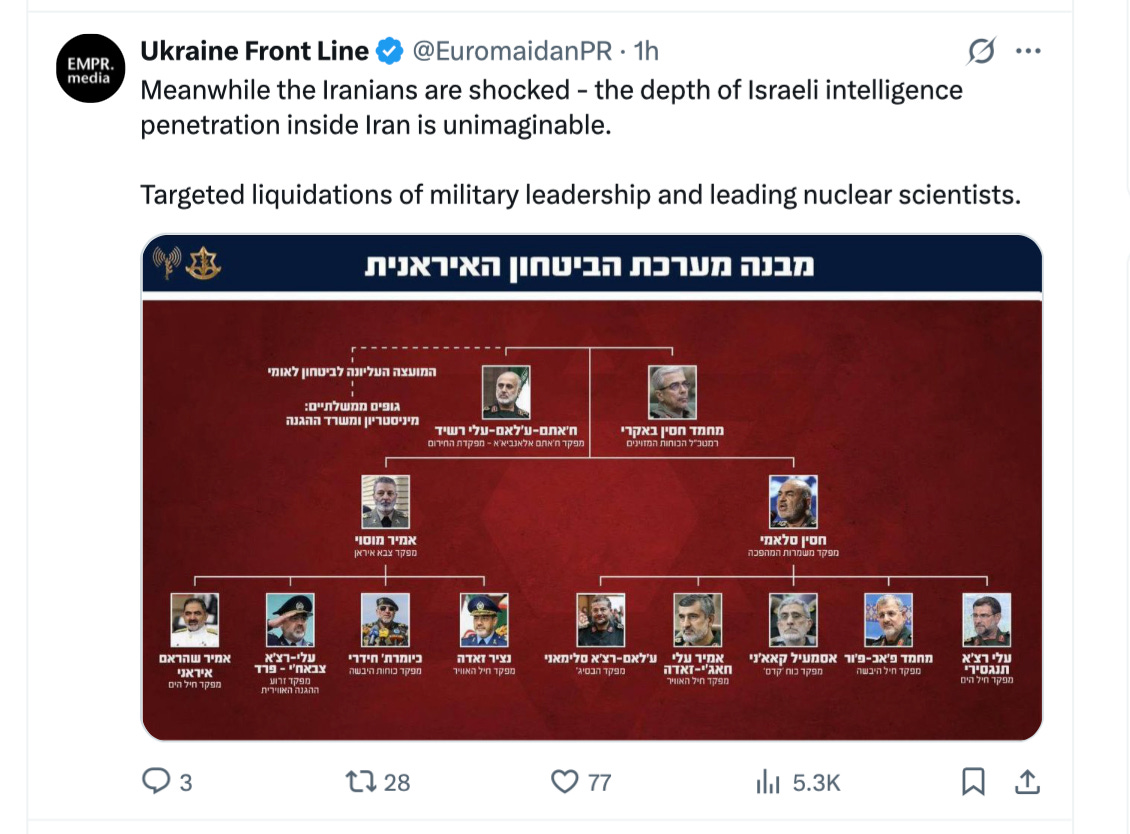
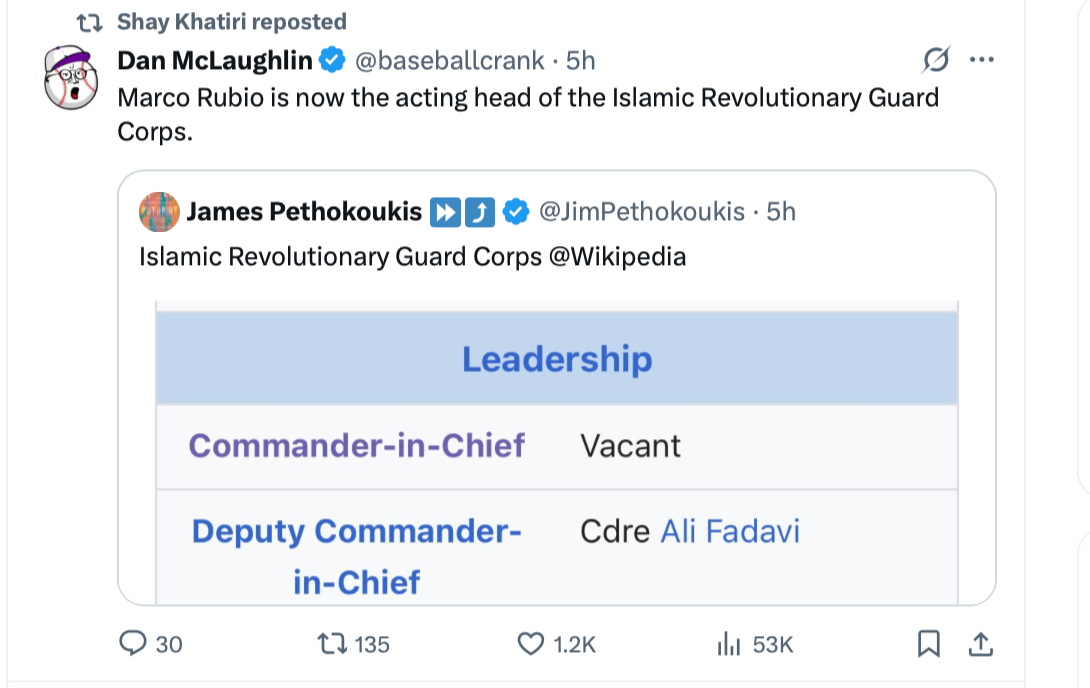
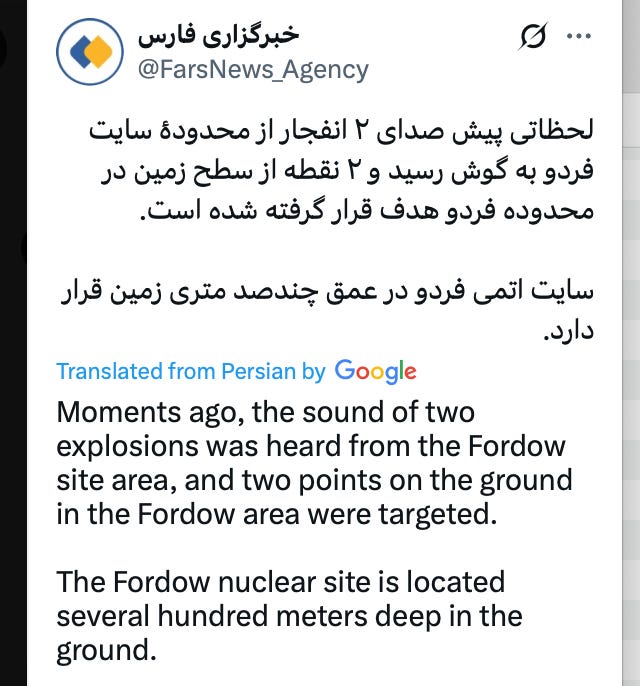






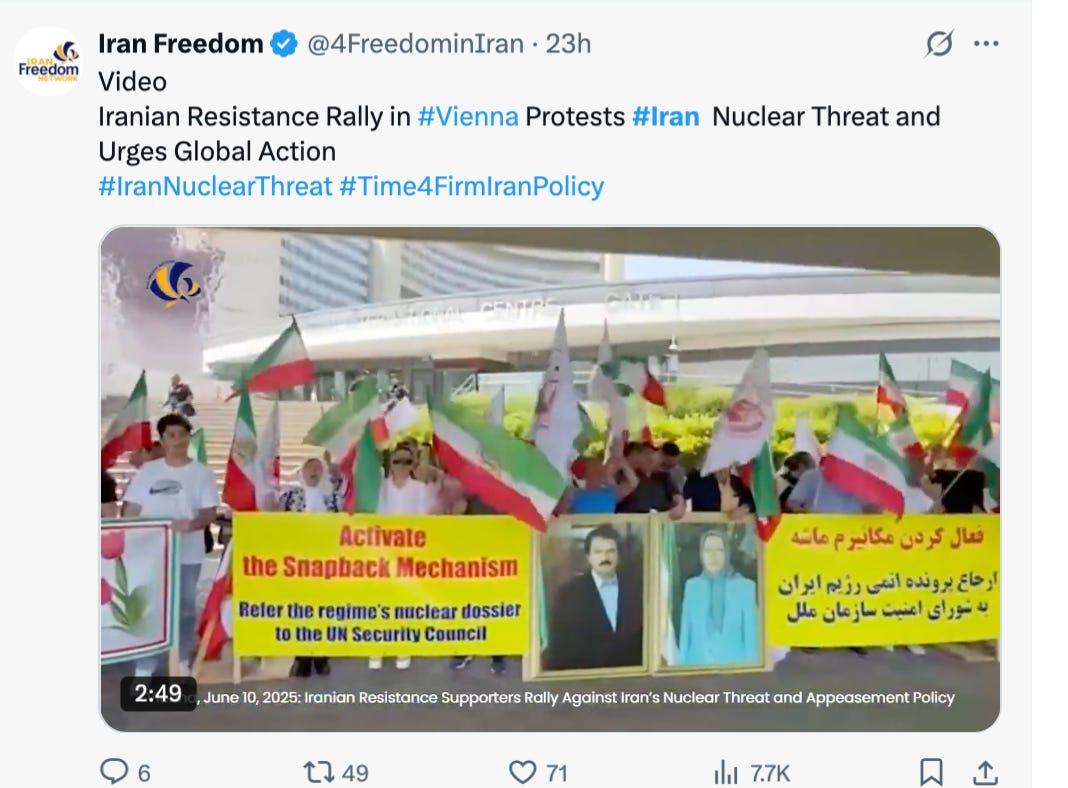
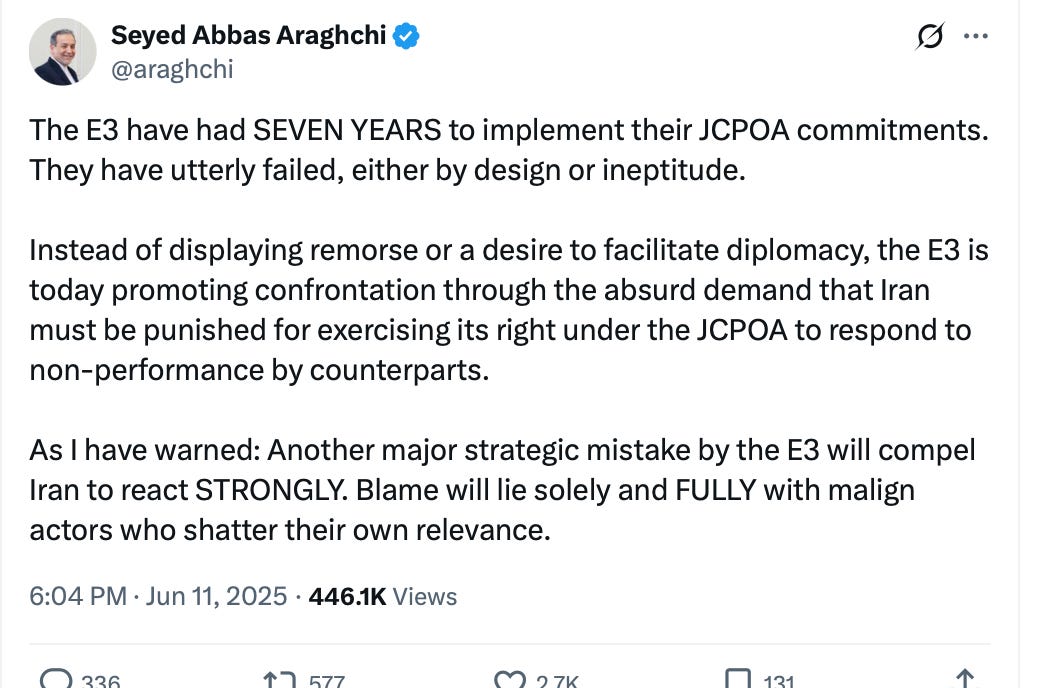



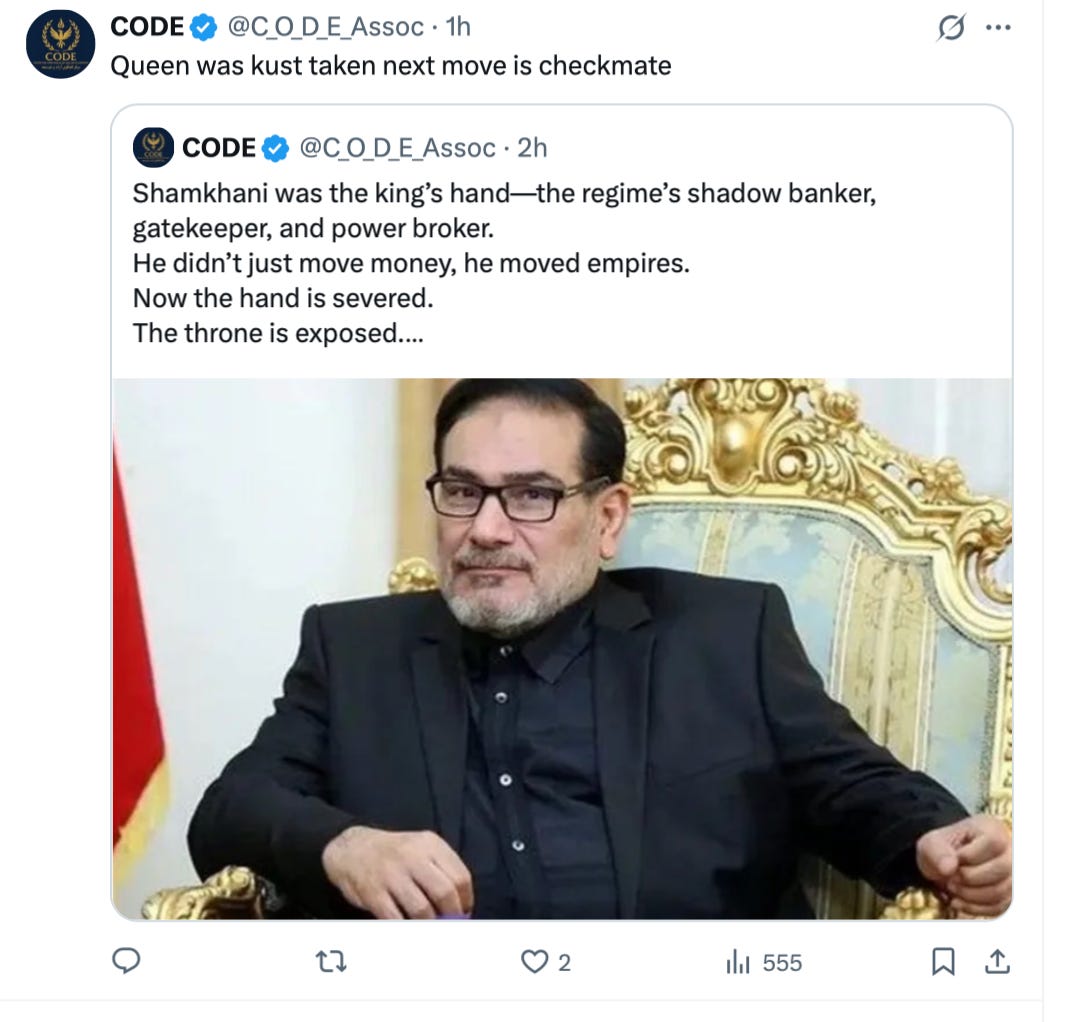








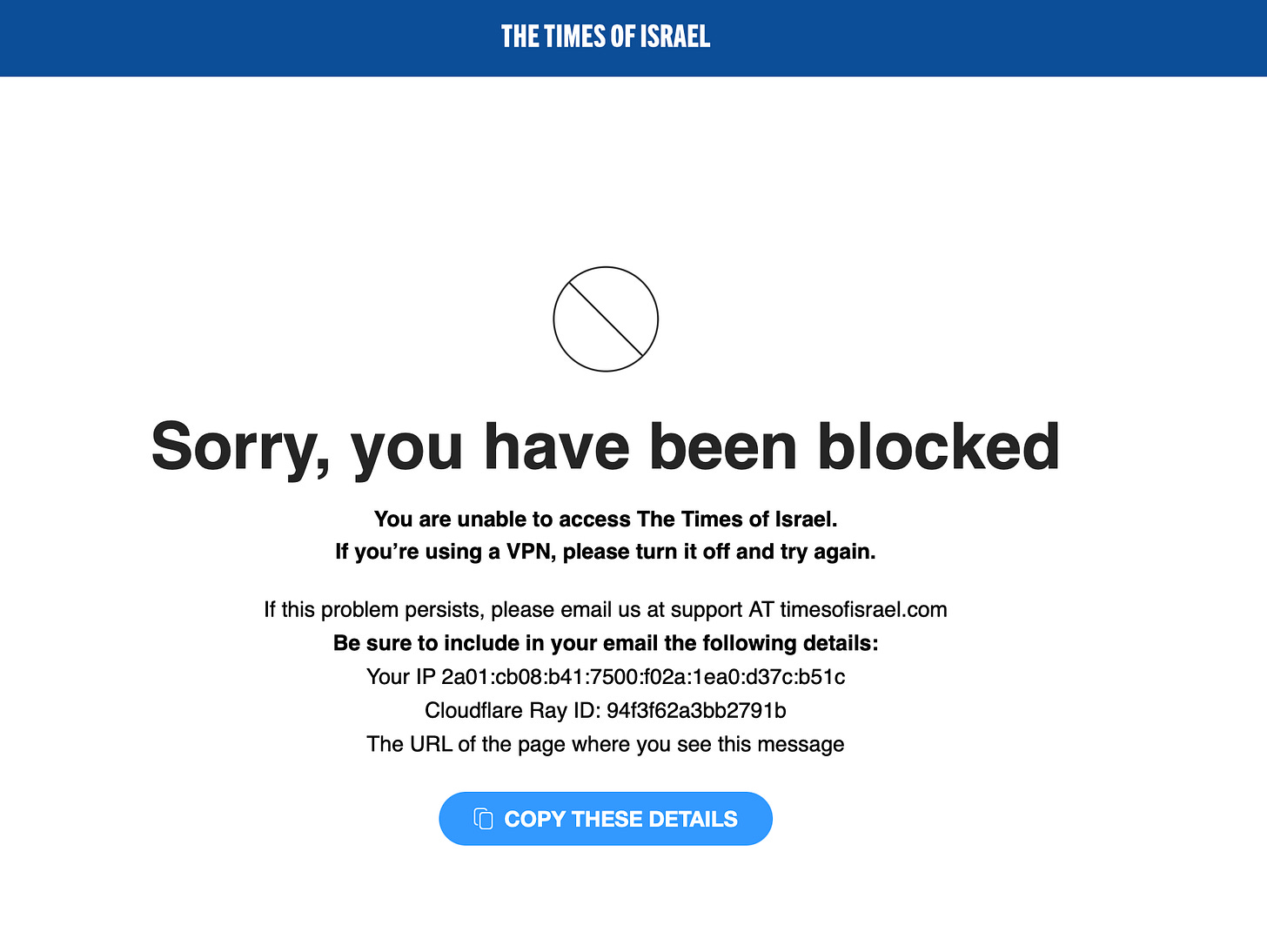

Lion or lioness? Both! Interlinears to the rescue –
https://biblehub.com/interlinear/numbers/23.htm
There's both kə·lā·ḇî (like a lioness) and wə·ḵa·’ă·rî (and like a lion) in Num 23:24.
"Look, a people like a lioness rises and like a lion lifts itself up, nor shall it lie down until it devours the prey and the blood of the slain [it] drinks."
Obviously, interlinear scripture – with translation side-by-side to the original – depends on an accurate side-by-side translation for those who can't read the original. Still, a pretty handy setup for those of us who can't.
Here’s what I have been wondering:
(1) Is it possible that bombing Fordow’s electrical grid and its passageways for egress and ingress will be enough to render the facility inoperable for an extended period of time?
(2) Even without the requisite bunker busters, is it possible that by continuously bombing the site, Israel could cause a radiation release in the facility that might render it very difficult for the Iranians to use?
(3) Given the fact that Iran’s only potential delivery system for nuclear weapons is its ballistic missile fleet, by destroying Iran’s ability to build and deploy these missiles, might Israel render an Iranian nuclear weapon largely irrelevant?